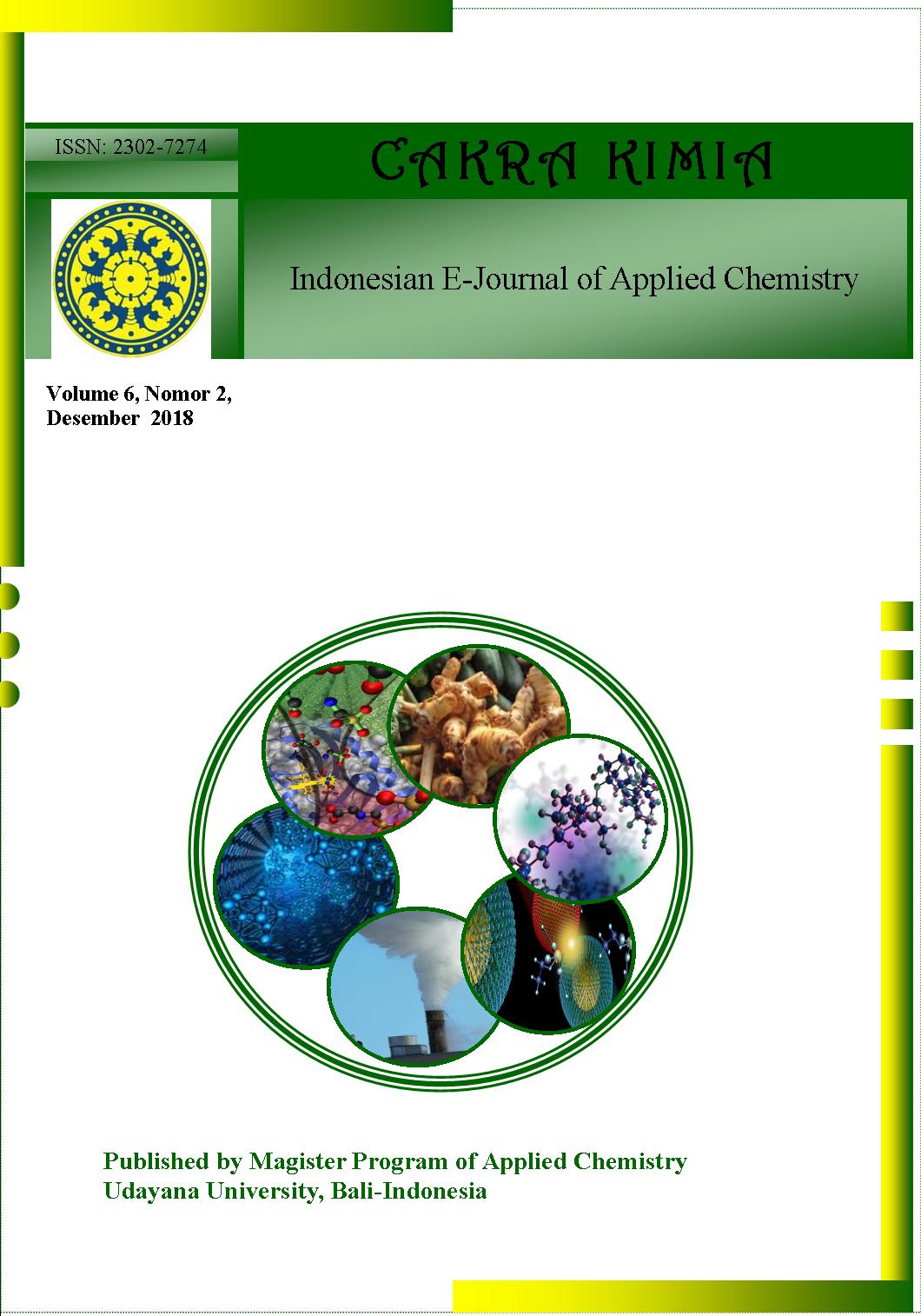SINTESIS KOPOLIMER CANGKOK KITOSAN-g-POLI(ASAM AKRILAT) SEBAGAI ADSORBEN KATION Cu2+, Pb2+, DAN Cr3+
Abstract
ABSTRAK. Sintesis dan karakterisasi kopolimer cangkok poli(asam akrilat) (PAA) pada kitosan (CS) {CS-g-PAA} sebagai penukar kation sudah dilakukan melalui kopolimerisasi redoks menggunakan cerium (IV)-sulfat sebagai inisiator. Konsentrasi dari monomer asam akrilat divariasikan pada konsentrasi 10%(v/v) dan 20% (v/v) dan juga variasi berat inisiator sebesar 0,1; 0,5; dan 1,0 gram. Data spektroskopi FTIR mengkonfirmasi keberhasilan proses grafting. Berdasarkan data spektroskopi FTIR, munculnya puncak serapan baru pada bilangan gelombang 1759,06 cm-1 (C=O).Persen grafting optimum diperoleh dan kopolimer yang disintesis menggunakan 0,5 gram cerium (IV) sulfat diperoleh sebesar 1066,18% (b/b) dan 2434,11% (b/b) berturut-turut untuk konsentrasi monomer 10% (v/v) dan 20% (v/v). pH optimum untuk adsorpsi Pb2+ dan Cr3+ adalah 6 sedangkan untuk yang diperoleh terhadap ion Cu2+ adalah pada pH 8. Kapasitas adsorpsi tertinggi yang diperoleh terhadap ion Cu2+ adalah 52,6 mg/g dan memungkinkan untuk meningkat. Tingginya kapasitas adsorpsi CS-g-PAA terhadap Cu2+ menunjukkan bahwa kopolimer ini merupakan penukar kation yang sangat baik
Kata kunci: hidrogel, kopolimerisasi grafting, kitosan-g-poli(asam akrilat), penukar kation, redoks
ABSTRACT. The synthesis and characterization of graft copolymer poly (acrylic acid) (PAA) in chitosan (CS) {CS-g-PAA) as cation exchanger were carried out by redox copolymerization using cerium (IV)-sulfate as an initiator. Concentrations of acrylic acid monomers were varied at concentrations of 10% (v/v) and 20%(v/v) as well as the variation of the initiator of 0.1; 0.5; and 1.0 gram. Analysis of the PAA was conducted using FTIR spectroscopy to confirm the process of grafting which revealed the existence of new absorption peak at 1759.06 cm-1 assigned to C = O. The optimum percentage of grafting and the synthesized of copolymer used 0.5 gram cerium (IV) sulfate were 1066,18%(b/b) and 2434,11%(b/b) respectively for the concentration of monomer in 10%(v/v) and 20%(v/v). The optimum pH for adsorption of Pb2+ and Cr3+ at 6, whereas for Cu2+ ion at pH 8. The highest adsorption capacity obtained on Cu2+ ions is 52.6 mg/g and that’s possible to increase. The higher capacity of CS-g-PAA adsorption to Cu2+ indicates that CS-g-PAA is an excellent cation exchanger.
Downloads
References
[2] Li, N and Bai, R., 2005, Copper Adsorption on Chitosan-cellulose Hydrogel Beads: Behaviors and Mechanisms, Separation and Purification Technol 42(3): 237-247
[3] Chen A.H, Liu S. C, Chen C-Yuan, and Chen, C-Yun, 2008, Comparative Adsorption of Cu(II), Zn(II) and Pb(II) ions in Aqueous Solution on The Crosslinked Chitosan with Epichlorohydrin, J Hazard mater 154(1-3):184-191
[4] Baran, A, Bycak, E, Baysal, S.H, and Onal S., 2006, Comparative Studies on The Adsorption of Cr(VI) Ions on to Various Sorbents, Bioresource Technol 98(3): 661-665
[5] Sankararamakrishnan, N., Sharma A.J., and Sanghi, R., 2007, Novel Chitosan Derivative for The Removal of Cadmium in The Presence of Cyanide from Electroplating Wastewater, J Hazard Master 148(1-2): 353-359
[6] Boddu V.M., Abburi K., Talbott J.L., Smith E.D., and Haasch R., 2008, Removal of Arsenic (III) and Arsenic (V) from Aqueous Medium Using Chitosan-coated Biosorbent, Water Research 42(3):633-642
[7] Jayakumar, R., Prabaharan, M., Reis, R. L., and Mano, J. F, 2005, Graft Copolymerized Chitosan-Present Status and Applications, Carbohydrate Polimer, 62;142-158
[8] Karthikeyan, G., Andalagan, K. and Andal, N. M., 2004. Adsorption Dynamic and Equilibrium Studies of Zn (II) onto Chitosan. J. Chem. Sci., 116(2) : 119-127.
[9] Yohan, Nur R., Hendrajaya R., dan Siradj E. S., 2006, Sintesis Kopolimer Tercangkok Asam Akrilat pada Film LLDPE, Jurnal Kimia Indonesia, 1(1) : 32-38
[10] Cahyaningrum, S. E., Narsito, Santoso, S. J. dan Agustini, R., 2010. Adsorption of Mg(II) Ion From Aqueous Solution on Chitosan Beads and Chitosan Powder. Journal of Coastal Development, 13(3): 179-184.



 Petunjuk Penulisan
Petunjuk Penulisan
